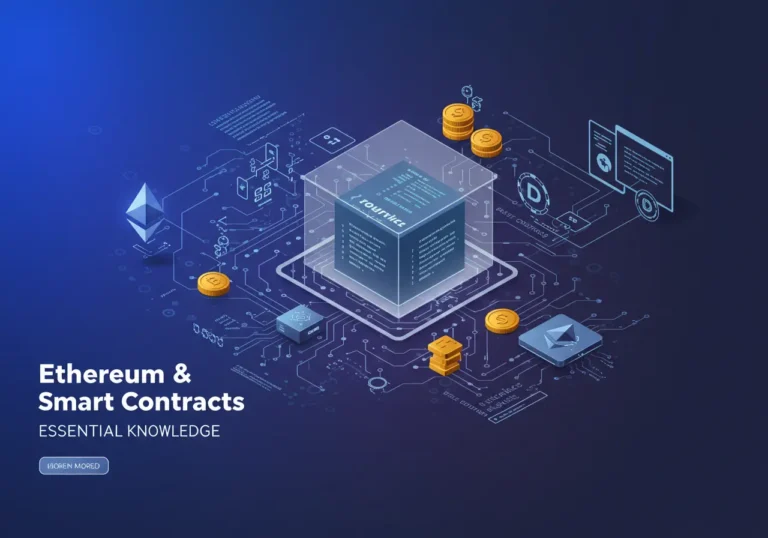What is a Liquidity Pool in DeFi
What is a liquidity pool: at its heart, a liquidity pool is a pot of tokens locked in a smart contract. These pools let people trade without a central exchange by acting as the counterparty for every trade. Instead of matching buyers with sellers, the pool itself supplies the tokens to trade against. That simple idea changed how markets work in DeFi.
What a liquidity pool looks like in practice

Imagine a lemonade stall. People bring lemons and sugar to a shared jar. When a customer wants lemonade, they take from the jar and leave money. The jar always has some balance of lemons and cash so the stall can sell without finding a single seller. A DeFi liquidity pool works the same way but with tokens.
Pools use formulas to set prices. The most common is the constant product formula used by many automated market makers (AMMs). In plain terms, it keeps the product of the two token amounts the same. When someone buys one token, they add the other token to the pool, shifting the price slightly.
Why liquidity pools matter: importance of liquidity pools in DeFi
Liquidity pools are the engine of the DeFi ecosystem. Here’s why the importance of liquidity pools in DeFi is easy to see:
- They let anyone trade tokens at any time without waiting for a matching order.
- They power decentralized exchanges, lending platforms, and yield apps.
- They democratize market making — ordinary users can supply liquidity and earn fees.
- They reduce friction in crypto markets, making small and large trades smoother.
Without pools, many DeFi services would stall or become expensive. Pools make the space fluid and usable.
How to provide liquidity in pools

One of the most asked questions is how to provide liquidity in pools. The steps are simple:
- Choose the pool. Popular pools pair major tokens like ETH/USDC or stablecoin pairs like USDC/USDT.
- Match the token ratio. Most pools require you to deposit tokens in a fixed ratio — often 50/50 by value. If you add $100 worth of ETH, you must add $100 worth of the paired token.
- Approve the smart contract. Your wallet will ask permission for the pool contract to access your tokens.
- Supply the tokens. Confirm the transaction and your tokens go into the pool.
- Receive LP tokens. In return, you get liquidity provider (LP) tokens that represent your share of the pool.
LP tokens are important. They let you withdraw your share later and sometimes earn additional rewards in other DeFi programs.
A tiny example
If you add $50 worth of Token A and $50 worth of Token B to a $1,000 pool, you hold about 10% of the pool. That means you will earn 10% of fees and can withdraw 10% of the pool later (minus any price changes).
How to calculate pool share in liquidity pools
People ask how to calculate pool share in liquidity pools often. The math is straightforward.
- When you deposit, the pool updates total liquidity.
- Your share = (your deposited value) / (total pool value after deposit).
For example, if the pool is worth $10,000 and you add $500, your share is $500 ÷ $10,500 ≈ 4.76%. LP tokens reflect this percentage. When you withdraw, you get your share of whatever tokens the pool holds at that time.
Fees and earnings: how LPs make money
Liquidity providers earn fees from every trade that uses the pool. Fees are usually a small percentage of each trade and are split among LPs by share. Some pools also offer extra rewards, like native tokens, to attract liquidity.
Earnings come from:
- Trading fees: Small slices of each trade go to LPs.
- Incentives/yield farming: Projects may give bonus tokens to LPs.
- Appreciation: If the underlying tokens rise in value, your share is worth more in fiat terms.
However, earnings are not guaranteed. There are real risks to consider.
Risks associated with joining liquidity pools

It’s important to cover risks associated with joining liquidity pools so you can decide calmly.
- Impermanent loss: This happens when token prices move relative to each other. Even if you earn fees, you might have been better off holding the tokens separately. The loss is “impermanent” because it changes with price — but if you withdraw at a loss, it becomes permanent.
- Smart contract risk: Pools run on code. Bugs or hacks can drain funds.
- Rug pulls and scams: New pools can be created by bad actors who remove liquidity later.
- Liquidity risk: If a pool has low liquidity, large trades can cause big price slippage.
- Token risk: One of the tokens may be unstable or lose value, reducing your pool share value.
Mitigate risks by choosing reputable pools, checking audits, and preferring established tokens or stablecoin pairs for lower volatility.
How to minimize impermanent loss
Impermanent loss worries many new LPs. To reduce it:
- Choose pools with similarly behaving assets (e.g., stablecoin-stablecoin).
- Use pools with small volatility or heavy fee income that offsets loss.
- Consider time horizon — long-term deposits may recover as markets move.
- Keep position sizes reasonable compared to your overall portfolio.
Understanding the trade-offs helps you pick where and when to provide liquidity.
Maximizing returns with liquidity pool strategies
If you want to think about maximizing returns with liquidity pool strategies, here are practical approaches:
- Choose high-volume pairs: More trades mean more fees distributed to LPs.
- Look for incentive programs: Many protocols give extra tokens to LPs for a limited time. That can boost earnings but adds complexity.
- Use stable pools for steady returns: Stable/ stable pools (like USDC/USDT) tend to have low impermanent loss and steady fees.
- Diversify: Don’t put all your funds in one pool — spread risk across pools and protocols.
- Monitor and rebalance: Check your positions and rebalance or withdraw if risks rise.
A balanced strategy mixes caution and opportunity.
Tools and checks before joining a pool
Before you add funds, do simple checks:
- Read the pool’s stats: total value locked (TVL), 24h volume, and fee structure.
- Check for audits and community reviews.
- Confirm LP token mechanics and withdrawal rules.
- Test small amounts first to learn.
- Keep wallet backups and never share private keys.
These steps protect your funds and give you confidence.
Conclusion — practical and human
A liquidity pool is a simple idea with broad power. Pools let markets run smoothly and give everyday users a way to earn fees. They also carry honest risks, from impermanent loss to smart contract flaws. If you think of pools like shared jars at a community stall, the picture becomes clearer: helpful, communal, but needing care.
Start slow, learn the mechanics, and pick pools that match your comfort with risk. With gentle steps and basic checks, you can use pools to learn DeFi and potentially earn returns while contributing to the market’s health.
Quick takeaways
- A liquidity pool is a smart contract where tokens are pooled to allow decentralized trading.
- How to provide liquidity in pools: choose a pair, match ratio, approve, deposit, get LP tokens.
- Importance of liquidity pools in DeFi: they enable instant trades and power many DeFi apps.
- Risks associated with joining liquidity pools: impermanent loss, smart contract bugs, low liquidity, scams.
- How to calculate pool share in liquidity pools: your deposited value ÷ total pool value after deposit.
- Maximizing returns with liquidity pool strategies: pick high-volume pools, use incentives wisely, diversify, and monitor positions.
Frequently Asked Questions
Q: What is the safest type of liquidity pool?
A: Pools with stablecoin pairs (like USDC/USDT) are typically safer from impermanent loss because the assets move together.
Q: How long should I stay in a liquidity pool?
A: There’s no fixed answer. Longer positions can allow fees to offset impermanent loss, but monitor market conditions.
Q: Can I lose all my funds in a pool?
A: While unlikely in well-audited pools with major tokens, smart contract exploits or rug pulls can result in total loss in risky projects.
Q: Do LPs need to pay taxes on fees earned?
A: Tax rules vary by country. Keep records of fees and consult a tax professional.
Q: What are LP tokens used for?
A: LP tokens prove your share and let you withdraw. They can also be staked in other protocols for extra rewards.
Table of Contents

Hello, I’m Edmilson Dias, founder of CoinBringer. I created this platform to guide people through the fast-moving world of cryptocurrency with clarity and safety. With years of research in blockchain and digital security, my goal is to translate complex topics into practical knowledge, offering reliable tutorials, safety insights, and guidance for both newcomers and experienced users.
Discover more from CoinBringer
Subscribe to get the latest posts sent to your email.







